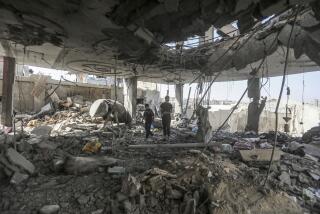Iraqis Spent Years Plotting Kuwait Strike : Strategy: The U.S. didn’t spot invasion preparations, officials say. A plan to seize Saudi oil fields may have been drafted 5 years ago.
DHAHRAN, Saudi Arabia — The United States has learned that Iraqi forces conducted secret military exercises for at least two years in preparation for their attack on Kuwait under a war plan designed ultimately to conquer the oil fields of eastern Saudi Arabia, according to U.S. officials.
Newly gathered intelligence indicates that the Iraqi plan, drafted by President Saddam Hussein as many as five years ago, envisioned no more than a strategic pause in Kuwait before Iraqi forces continued southward into Saudi Arabia, the knowledgeable officials said.
Among the “multiple” exercises now understood to have served as trial runs for the long-planned invasion was a mid-July dress rehearsal in central Iraq in which elite special operations forces practiced for the helicopter-borne assault on Kuwait city that launched the Iraqi invasion Aug. 2.
The sources said that the years of preparation also appear to have helped an advance party of Iraqi commandos make their way into Kuwait immediately before the invasion by posing as a sports delegation on a long-arranged visit. Instead, the “athletes” guided Iraqi helicopters to their targets.
By contrast, the United States was so ill-prepared for the invasion that U.S. warships dispatched hastily to the region after the attack had to wait four days before maps of Kuwait and Iraq could be prepared and loaded into computers used for guiding weapons, the officials said.
The new findings, circulated by the U.S. intelligence community, provide what the officials said was compelling evidence that the surprise Aug. 2 attack was in fact the product of a long-drafted plan aimed at winning control of half the world’s supply of oil.
“It’s clear that he (Hussein) was exercising for this at least two years ago,” said one source who was briefed on the new intelligence. “There’s good--but not entirely conclusive--evidence that he began planning another three years before that.”
That the information was uncovered only in the aftermath of the invasion, however, also raises new questions about the failure of the United States to detect and respond to the preparations sooner.
The two-year series of Iraqi military exercises, whose purpose became apparent only in hindsight, “probably should have been seen to add up to something,” one official said.
Instead, at the highest levels of the Pentagon and State Department, “nobody had really done any serious planning for this contingency,” another source said. When the invasion came, he noted, the military did not even have a deployment plan to fall back on.
The new disclosures come in the wake of concern about the failure of the United States to predict the invasion even after Iraqi troops began to mass on the Kuwaiti border. Administration officials have said that the intelligence community provided adequate warning that Iraq was capable of attack but that policy-makers chose to discount the alert, believing that the buildup was nothing more than a show of force.
However, some officials said the fact that Iraqi preparations had been carried out over a lengthy period of time should be cause for deeper concern about the adequacy of U.S. efforts to monitor and analyze events inside Iraq.
“When you go back and look at the information,” one source said, “the previous weeks all add up.”
The special Iraqi exercises conducted in advance of the invasion included several conducted on terrain apparently chosen for its similarity to that of Kuwait, officials said. But they declined to provide further details.
They also did not reveal how the United States had learned of the existence of the Iraqi war plan, which officials said Hussein may have been drafted as early as 1985, when Iraq was in the midst of a stalemated war with Iran.
But a knowledgeable source said that the plan was regarded by intelligence officials as a definitive indication of Hussein’s intentions.
“Every army has plans--the French probably even have a plan to invade Washington,” he said. “But this is something different. This guy acts on his plans.”
Another official confirmed that the strategy was “clearly directed to take over the oil fields of eastern Saudi Arabia.” But he said the exact extent of Hussein’s territorial ambitions was unclear because “he was planning a military rather than a political end game.”
Similarly, the source said that while intelligence officials now believe that the plan Hussein launched on Aug. 2 called for his forces to continue through Kuwait and into Saudi Arabia, it remains unclear whether his “strategic pause” at the Saudi border “was for military reasons or to determine whether he could get away with it.”
Arab diplomats previously told visiting U.S. Congress members of similar indications that Hussein had planned to continue southward, including reports that he offered to divide the spoils of his land grab with other Arab leaders.
But in emphasizing the importance of the newly gathered intelligence, the sources said the earlier evidence had been no more than “circumstantial.”
While criticizing the general lack of preparedness by the U.S. military and diplomats for an Iraqi attack, the U.S. officials said a notable exception was Gen. H. Norman Schwarzkopf, head of the U.S. Central Command and now commander of all U.S. forces in Operation Desert Shield.
Only two weeks before the invasion, the officials said, Schwarzkopf convened his top commanders for an exercise that simulated “exactly the contingency” of an Iraqi attack on Kuwait.
“The similarities were eerie,” one source said. He added that “when the real thing came, the only way they could tell the real intelligence from the practice intelligence was the little ‘t’ in the corner of the paper--’t’ for training.”
More to Read
Sign up for Essential California
The most important California stories and recommendations in your inbox every morning.
You may occasionally receive promotional content from the Los Angeles Times.










